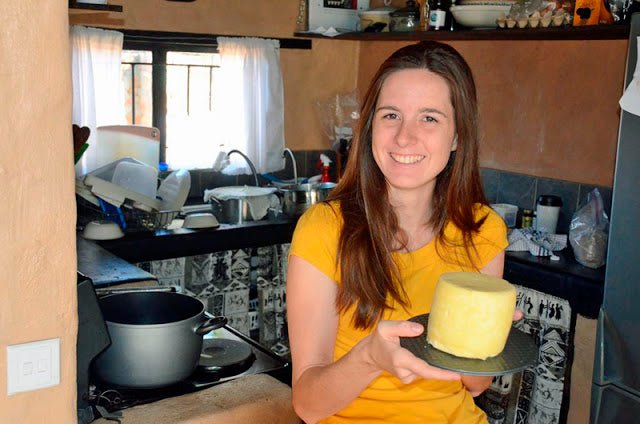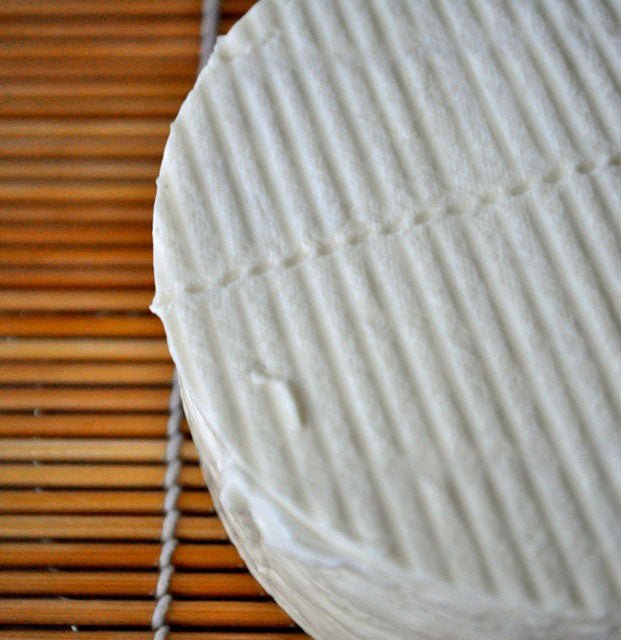If you are moving to Zambia, you might want to learn how to make cheese first!

 |
| Ashley with her Caerphilly. |
And, you might want to bring your own supplies with you. (Although, believe it or not, we do ship to Zambia.) As you will see, in Ashley Keller’s description of the conditions there, making cheese can be a real challenge.
Ashley and her husband, Tim, are raising two young children while working as missionaries in Africa. They primarily work with teachers there, training them and providing them with supplies through their Container Project. You can read more about their work at their website.
 |
| Ashley holding her daughter, Monica, while son Frederick fusses. |
We met Ashley when she sent in a response to Janie Zencak’s request for ideas about drying cheesecloth in a humid climate:
I’m an amateur (very amateur) cheesemaker in Zambia. I had the same problem last rainy season! It was so frustrating to produce beautiful curds only to spoil them with yeasty cheesecloth.
I finally started drying them in the sun with an electric fan blowing on them. If I don’t have access to electricity, I dry the cloth as best as I can.
 |
| Ashley and Frederick in Kanakantapa. Photo taken from the top of a 20′ high ant hill. |
How did you get started making cheese?
My husband, Timothy, and I (and our two littles Monica (3) and Frederick (1) ) are missionaries in Zambia. We developed a passion for cheese in the winelands of South Africa. When we decided to move our ministry north to the bush country of Africa, I realized this would mean giving up cheese- unacceptable!!
 |
| Ashley’s husband, Tim with Sudanese men. |
We went on furlough to the States to have our first baby. While there I looked into cheese making. I bought “Home Cheese Making“, but was a little overwhelmed by the number of ingredients and detailed recipes. I decided to try making raw milk cheese (the kind you just leave on the counter to culture itself). It worked GREAT in the States. Fortunately, I had enough experience in Africa to question how sanitary the raw milk would be, so I bought the basic cheese making supplies anyway.
As soon as we settled in Kabwe, Zambia I started making raw milk cream cheese. I think I got one good batch out of about 10. They turned red, black, purple, grew fur, grew maggots… it was so gross. So I girded my loins and tried the lactic cheese and bondon cream cheese. They turned out so well!
I thought I’d overcome all my problems, so I tried hard cheeses next. After THREE failed hard cheeses I was feeling extremely discouraged (first one tasted VERY sour and bitter and had funny holes, second one had funny holes and smelled like refuse, third one just plain exploded. Not even kidding).
 |
| Ashley holding Frederick (who she says is pretty much attached at the hip) while pasteurizing milk for cream cheese. |
About that time, a missionary who runs a dairy farm in Australia passed through (what are the odds?). I told him my sorrows and he had a very simple answer for me: poop in the milk. Ew. So I actually started pasteurizing it. Ha, ha. Should have done that to start with right? Duh. I was hoping I could avoid the extra work.
 |
| Curds draining in Ashley’s single basin sink. |
Problem was I didn’t have a thermometer (the one I bought with the cheese supplies didn’t work, probably got damaged on the trip to Africa). I got my mom to mail a candy thermometer from the States and I was back in business.
From there I was pretty successful. I’ve made feta quite a few times and it’s very popular with our friends (who also have little access to cheese).
I make about 3 gallons worth of cream cheese every week (usually the lactic cheese recipe simply because I can’t rely on extra cream that hasn’t soured being readily available). Some of the cheese we share or trade, but a lot of it we just eat.
My husband has a whey allergy (how ironic, I know), so I can use pressed lactic cheese in place of milk in most recipes. Plus, I’ve found that when our electricity goes off, the cheese doesn’t go off like the milk does! Yay for lasting food products!
 |
| Caerphilly pressing in homemade Mukwa wood cheese press with an African made brick for a weight. |
I still haven’t conquered cheddar. I think part of my problem was not having a proper press. I bought a beginner one recently in the States so I think I’ll give it a try very soon.
I made Caerphilly last week with a press my hubby built for me (works but doesn’t press evenly). The cheese is a bit lopsided, but otherwise seems to be developing a gorgeous rind.
The recipe appealed to me because of the short aging time. I have no way of keeping the cheese out of the elements here. It’s sort of cloistered in a corner by my fridge. If I can keep the bugs and fungus away from it for another week, I think I’ll have a success.
How is making cheese different there from here?
 |
| On their way to sell vegetables at the market |
I haven’t made very much cheese at all in the States, so I’ve basically just accepted conditions out here as “the way it is”.
It’s hard for me to say for sure how it’s different, but a few things I’ve come to realize: in the States we take for granted sanitation codes and laws!!!!
The milk out here is really so nasty. After making scores of batches of just cream cheese, I can now tell by smell when the cheese is fully pasteurized or how close to soured fresh milk is. If it isn’t pasteurized it just smells like sour manure!!
 |
| Waiting in line to hold baby, Frederick AKA Mr. Popular |
Another problem is the airborne fungus. It’s incredible what GROWS out here. Leaving a cheese out to age at any time of the year makes for an interesting science project, but leave one out in the hot & humid months of November and December….
I have to wipe the cheese down with vinegar every few hours. Overnight it will grow lichen like fungus… that MOVES. It’s crazy.
Because of the fungal issue I have to boil all my cheese cloth or wash it in bleach before I use it. During the very hot/dry months of the year I sometimes skip this for cream cheese, but never EVER for hard cheese. I lost my first few batches of cream cheese and whey ricotta to airborne fungus.
Now I hang my cheese cloth from a spoon inside a 16qt stock pot that I cover with a towel. So far that has worked like a charm. There are just to many bugs in the air here!
 |
| Monica in Chipota getting a sunburn, but having a good time. |
The next issue is temperature. We have 3 seasons here: end of December – March is hot & rainy (like rains 10 hours a day or more), April – July is winter (60 at night, 80 during the day), August – December is very, very hot (100ish) and dry.
So basically, if a cheese needs be stored under 75ish degrees and over the fridge temperature of about 45, then I’m pretty much sunk. There is just no option.
I’ve told our friends if they have a fridge that doesn’t stay very cold any more I WANT IT. But so far no one’s fridge has broken.
Cockroaches are a problem out here. I keep my kitchen EXTREMELY clean and pretty much everything is stored in sealed containers, but every 4 months or so, I have to haul everything out and spray poison, bleach, and scrub. I hate bugs! Besides, I know it’s a threat to my cheese.
Another challenge is supplies. I can get a very few things from South Africa, but they don’t like to ship them to me (too much theft in the mail system).
I can, of course, order great materials in the States and have them shipped to my mom, who ships them to me, but it can take anywhere from 3-20 weeks to arrive depending on how the customs and mail officials are feeling at the time.
I can’t risk cultures and rennet in the heat and other conditions (we had one package arrive once where the cardboard and half the contents were almost completely eaten up by termites!)
My solution so far has been to stock up on cheese supplies every time we go to the States and have anyone traveling this way bring me resupplies.
I also take really good care of my mesophilic mother culture. I lost one a few weeks ago to stupidity (new resolution: do not attempt cheesemaking project before consuming morning cup of coffee) and almost cried. Fortunately I had a back up packet of C1 in the freezer and made another one. If I lose this batch, I’m in trouble!! It has to last me at least a year.
 |
| A water buffalo. In a few years they’re hoping to get a bigger piece of land and then Ashley wants one (domesticated of course!). |
What do you hope to achieve with your cheese making?
My next step is to get control of my inner cheddar and then start with thermophilic cheeses. Someday I’d love to make mold ripened cheese, but until I have a CLEAN, temperature controlled place to store them, I’m not even going to bother.
When I first started cheese making, I looked on it as a semi-burden/hassle/necessary evil. Now it’s close to a passion/obsession. My husband is very supportive. Aside from the fact that he loves cheese too, I think he’s glad I found a hobby out here that isn’t expensive (try buying imported scrapbooking supplies!) In the long run, I’m hoping to train African women to make basic cheeses. To make it sustainable for them, I need to find a rennet solution though. Obviously they won’t be able to import from the US.
If anyone has any suggestions for homemade rennet I’d love to get the method. I understand there is a way to make it from goat intestine. Not something I have the stomach for (pardon the pun), but probably something the African women would be comfortable doing. I’m also looking for recipes that don’t call for direct set cultures. It’s too difficult for me to get them, and it isn’t sustainable for me like a mother culture is.
For more info about Ashley and her family, check out their blog- Caution May Contain Nuts and their website- Keller Projects.





















































































































































